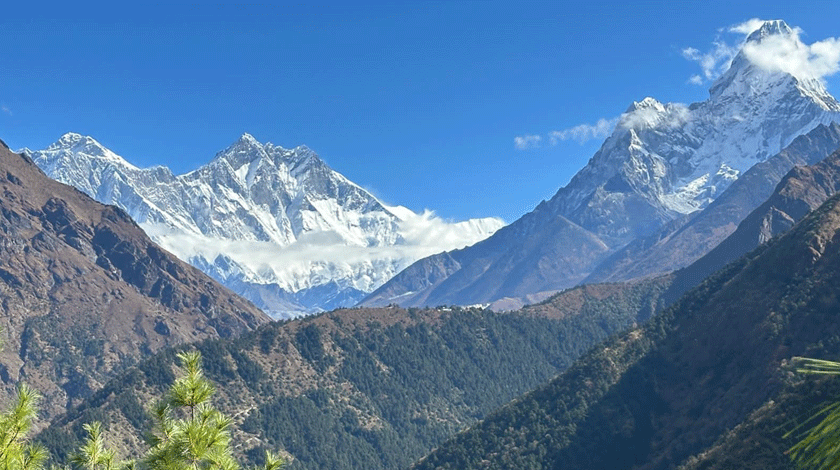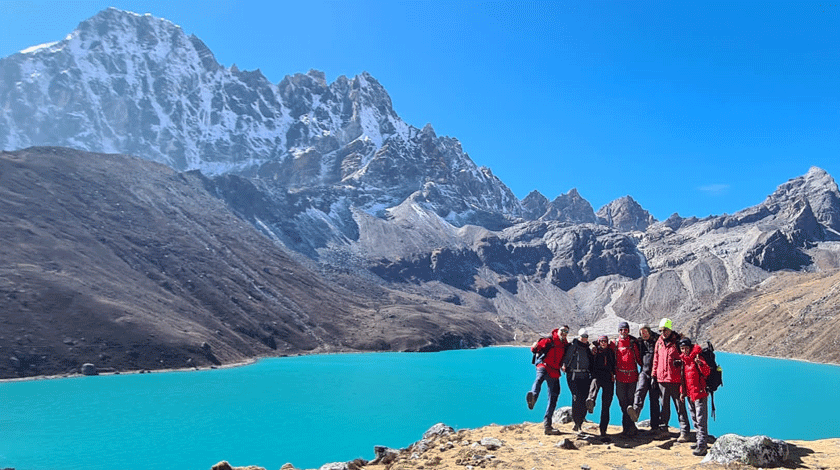Explore Sagarmatha National Park: Nepal’s Himalayan Jewel

Sagarmatha National Park is one of Nepal’s most celebrated destinations, attracting trekkers, mountaineers, and nature enthusiasts from around the globe. Famous as the home of Mount Everest (Sagarmatha), the park combines towering peaks, lush valleys, rare wildlife, and rich Sherpa culture. Whether you are trekking, exploring unique flora and fauna, or immersing yourself in local traditions, Sagarmatha National Park offers an unforgettable experience.
Geography and Location
Nestled in the Solukhumbu District of Province No. 1, Nepal, Sagarmatha National Park spans an area of 1,148 square kilometers. Its altitude ranges from 2,845 meters at Monjo to 8,848.86 meters at Everest’s summit, creating some of the most extreme and breathtaking landscapes in the world. Glacial rivers, alpine forests, and snow-covered peaks dominate the terrain.
The park shares its northern border with Tibet’s Qomolangma National Nature Preserve, forming a transboundary conservation area. Its geography allows trekkers to witness dramatic landscapes, including deep valleys, towering ridges, glaciers, and high-altitude lakes.
History and Establishment
Sagarmatha National Park was established in 2032 BS (1975 AD) to protect its fragile Himalayan ecosystems. In 1979, UNESCO recognized it as a World Heritage Site, acknowledging both its natural beauty and cultural significance. The park preserves high-altitude ecosystems, glacial landscapes, and the traditional lifestyle of local Sherpa communities.
Cultural Heritage
The park is rich in Sherpa culture, with monasteries, prayer flags, mani walls, and warm hospitality adding depth to the trekking experience. Key festivals include Losar, the Sherpa New Year marked by rituals, feasting, and dances; Dumje, a summer festival celebrating community and Buddhist traditions; and Mani Rimdu, a colorful event at Tengboche, Thame, and Chiwong monasteries featuring sacred dances and prayers. These festivals preserve Sherpa identity and offer visitors a glimpse of living Himalayan traditions amidst the world’s highest peaks.
Flora and Fauna
Despite its harsh climate, Sagarmatha National Park supports diverse wildlife and vegetation:
- Animals: Snow leopards, red pandas, Himalayan tahrs, musk deer, Himalayan monals, and over 118 bird species.
- Flora: Rhododendron forests, juniper shrubs, medicinal plants, and alpine grasses.
The park’s biodiversity makes it a paradise for wildlife enthusiasts, photographers, and trekkers seeking a deep connection with nature.
Getting to Sagarmatha National Park from Kathmandu
Most travelers reach Sagarmatha National Park from Kathmandu by taking a short flight to Lukla, the gateway to the Everest region. The flight takes approximately 35 minutes, followed by trekking to Monjo, the official park entrance.
For adventure seekers, overland routes through Jiri or Phaplu are also available, though they require additional days. Both options immerse visitors in Nepal’s cultural and scenic diversity.
Weather in Sagarmatha National Park
Weather in the park varies depending on altitude and season:
- Spring (March–May): Clear skies, blooming rhododendrons, moderate temperatures.
- Summer/Monsoon (June–August): Rain, landslides, limited visibility.
- Autumn (September–November): Stable weather, ideal trekking season.
- Winter (December–February): Cold, snow in high areas, fewer crowds.
Understanding Sagarmatha National Park weather is crucial for a safe and enjoyable trek.
Iconic Landmarks and Trekking in Sagarmatha National Park
Sagarmatha National Park is home to some of the most iconic landmarks in the world. Many of these landmarks are central highlights along popular trekking routes, offering both adventure and breathtaking scenery.
1. Everest Base Camp
The trek to Everest Base Camp is a once-in-a-lifetime journey for trekkers worldwide. Along the way, you encounter sweeping vistas of the Khumbu Glacier, dramatic mountain landscapes, and Sherpa villages. Everest Base Camp itself provides a close-up view of the world’s tallest peak, Mount Everest, making it the ultimate trekking goal in Sagarmatha National Park.
2.Gokyo Lakes
The Gokyo Lakes are a series of turquoise glacial lakes nestled amidst snow-capped peaks. Trekkers taking the Gokyo Ri Trek can enjoy panoramic views of Everest, Cho Oyu, and other Himalayan giants. The serenity of these lakes provides a peaceful contrast to the challenging high-altitude trek.
3. Khumbu Glacier and Icefall
Khumbu Glacier, the highest glacier in the world, stretches from the slopes of Everest down to the lower Khumbu region. Its Khumbu Icefall, at the west end of the Lower Western Cwm, presents a formidable challenge for climbers aiming for Everest’s summit. Trekkers on the Everest Base Camp route pass alongside this magnificent glacier during the final stretch, witnessing the raw power of ice and snow.
4. Kala Patthar
At 5,555 meters, Kala Patthar is the most famous viewpoint in Sagarmatha National Park. It offers stunning panoramic views of Everest, Lhotse, Nuptse, Ama Dablam, and surrounding peaks. Most trekkers visit Kala Patthar before returning to Lukla. While it doesn’t require a climbing permit, the high altitude and thin air make the ascent challenging yet incredibly rewarding.
5. Namche Bazaar
Known as the gateway to Mount Everest, Namche Bazaar sits at 3,440 meters and serves as the heart of the Khumbu region. This bustling town is a vital stop for acclimatization, offering shops, cafes, trekking gear, and even Wi-Fi. Trekkers often explore Namche Bazaar to experience Sherpa culture and local life before continuing their journey.
6. Mountains of Sagarmatha National Park
Sagarmatha National Park is not only home to Mount Everest but also a range of other iconic Himalayan peaks. Towering alongside Everest is Lhotse (8,516 m), the world’s fourth-highest mountain, and Nuptse (7,861 m) with its dramatic ridgeline. The graceful Ama Dablam (6,812 m) is often considered one of the most beautiful peaks in the world, while Thermasarkhu (6,608 m) and Kwangde (6,011 m) add to the park’s striking skyline. Equally impressive is Khangtiaga (6,783 m), completing a panorama that makes Sagarmatha National Park a true mountaineer’s and trekker’s paradise. These mountains dominate the skyline and form the backdrop for all treks in the region.
7. Tengboche Monastery
Tengboche Monastery is the largest monastery in the Khumbu region and a spiritual hub for the Sherpa community. It follows the Nyingma lineage of Tibetan Buddhism and welcomes trekkers seeking peace and cultural insight. The monastery’s traditional architecture, colorful murals, and intricate woodwork, combined with views of Ama Dablam, make it a truly unforgettable landmark.
Trekking and Tourism in Sagarmatha National Park

Tourism is a key part of the region’s economy and cultural exchange. Every year, thousands of trekkers and climbers visit, supporting local businesses including lodges, teahouses, guides, and porters.
- Trekking Tourism: Treks like Everest Base Camp and Gokyo Lakes provide income for local communities and fund conservation.
- Cultural Tourism: Tourists experience Sherpa traditions, monasteries, and festivals.
- Eco-Tourism: Responsible trekking, waste management, and eco-lodges protect the fragile environment.
- Adventure Tourism: Mountaineering and high-altitude exploration attract adventurers globally in the region.
Tourism in Sagarmatha National Park fosters sustainable economic growth while educating visitors on environmental conservation and cultural respect.
Conservation Challenges
- Despite its protected status, the park faces challenges:
- Waste management: Litter from trekkers and climbers threatens ecosystems.
- Climate change: Glacial melting and changing weather patterns impact biodiversity.
- Tourism pressure: High footfall can strain resources.
- Wildlife threats: Poaching and habitat disruption affect rare species.
Ongoing efforts, including eco-friendly trekking initiatives, community education, and stricter regulations, aim to mitigate these challenges.
Permits for the Region
Trekking in Sagarmatha National Park requires the following permits:
- Sagarmatha National Park Entry Permit: Mandatory for all visitors.
- TIMS Card (Trekkers’ Information Management System): Tracks trekkers for safety and management.
- Pasang Lhamu Rural Municipality Fee: A local fee collected to support community development and maintenance of trekking infrastructure.
These permit fees help fund conservation efforts, infrastructure, and local communities, ensuring sustainable trekking in the region.
Features and Facts
Features:
- Towering Himalayan peaks, including Everest.
- Rich Sherpa culture and traditional villages.
- Diverse wildlife and alpine flora.
- Glaciers, rivers, and high-altitude lakes.
- UNESCO World Heritage Site.
Facts:
- First national park in Nepal recognized as a World Heritage Site.
- Protects one of the highest-altitude ecosystems on Earth.
- Home to over 6,000 Sherpas.
- Trekking permits are mandatory.
- Contributes significantly to eco-tourism in Nepal.
Conclusion
Sagarmatha National Park is more than a trek; it is a journey into the heart of Nepal’s Himalayas. With breathtaking landscapes, rich biodiversity, vibrant Sherpa culture, iconic landmarks, and thriving tourism, the park offers an unparalleled adventure. From Everest Base Camp to Gokyo Lakes, every step reveals the wonders of this Himalayan jewel. Whether you are a seasoned trekker, nature lover, or cultural explorer, in the region promises an experience of a lifetime.







